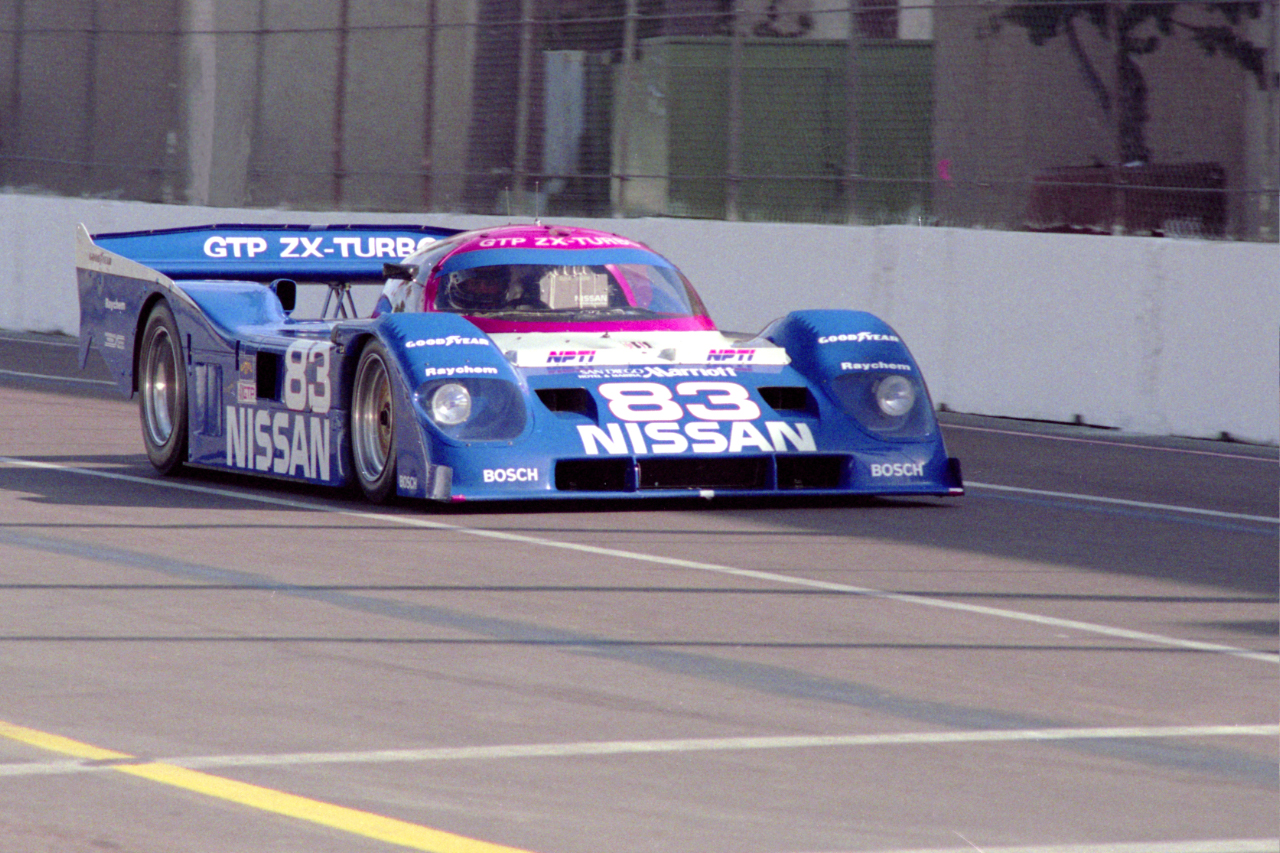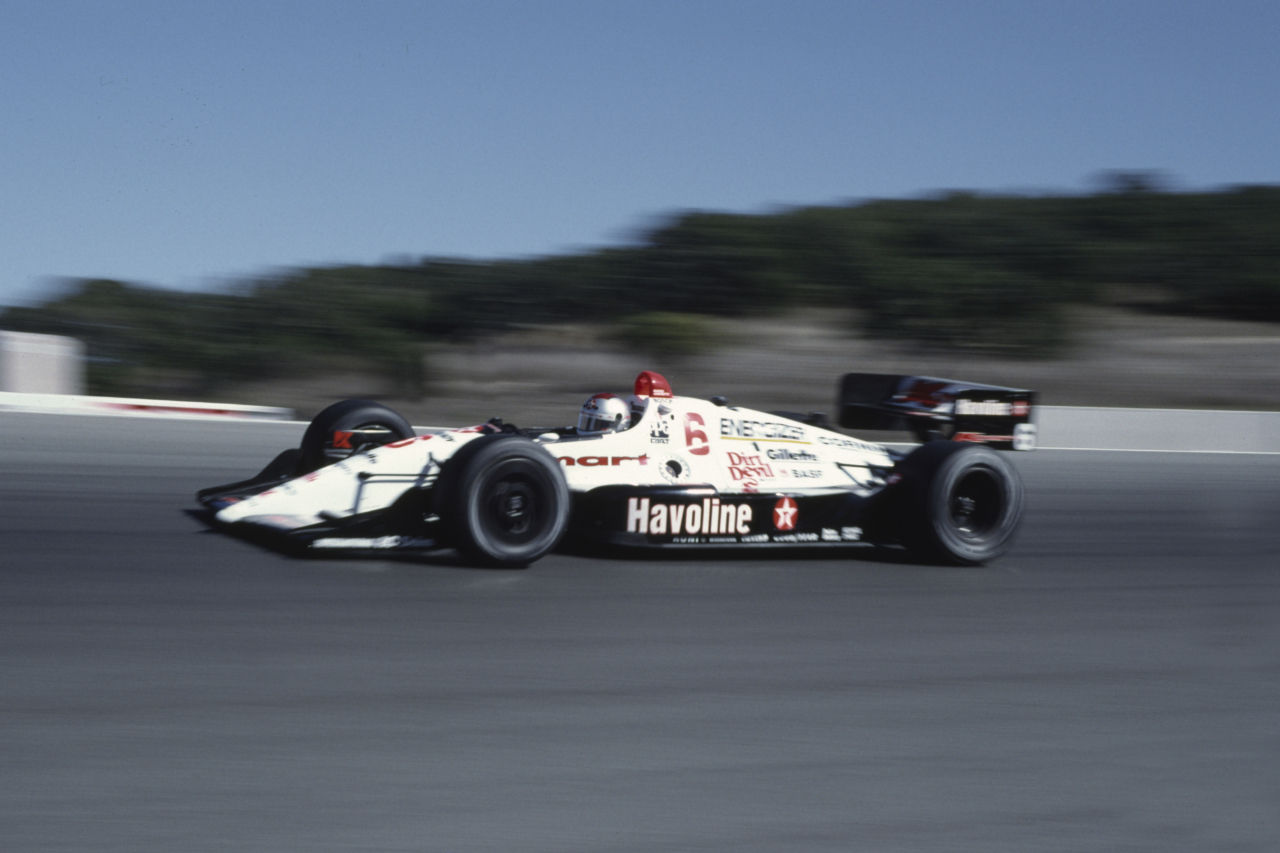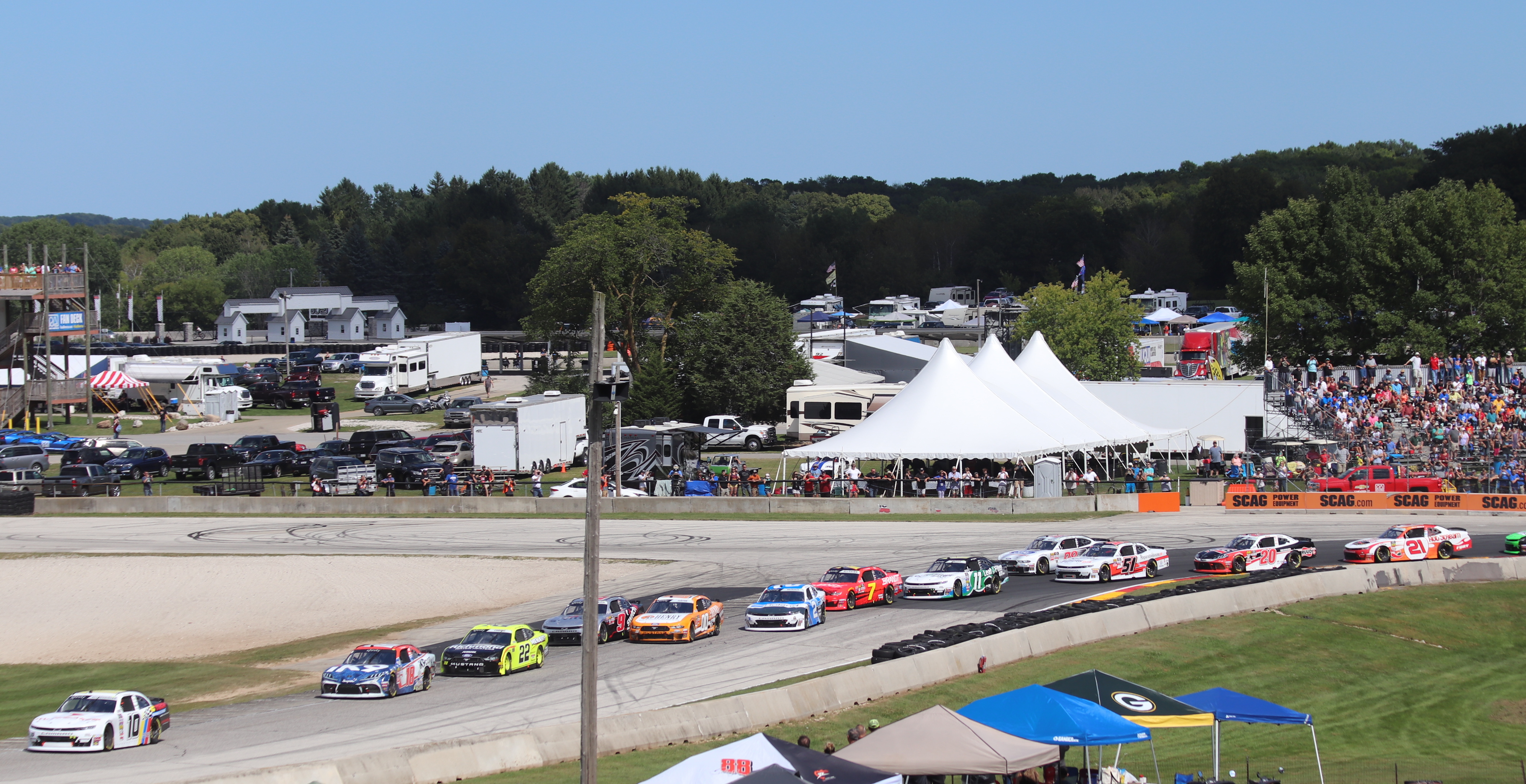|
March 817
The March 817 was a British sports prototype racing car, built by March Engineering in 1981 for the Can-Am series. As with all other full-size Can-Am cars of the time, it used a mid-mounted 5-litre, naturally-aspirated Chevrolet V8 engine. Two cars are known to have been built. Paul Newman Racing won the Team's championship of the Can-Am series in 1981 with the March 817, whilst their main driver, Teo Fabi took second in the driver's standings. Racing history Both March 817s were bought by Paul Newman Racing, with Al Unser and Teo Fabi initially being selected to drive them. The car made its first appearance in the first round of the 1981 Can-Am season, held at Mosport Park; Unser retired due to brake failure after 12 laps, but Fabi won the race. Unser wasn't present at Mid Ohio, but Fabi won again in a close race. Unser returned at Watkins Glen, but the weekend proved to be unsuccessful; damage to the rear end of his car forced Unser out after 16 laps, and Fabi retired wit ... [...More Info...] [...Related Items...] OR: [Wikipedia] [Google] [Baidu] |
Can-Am
The Canadian-American Challenge Cup, or Can-Am, was an Sports Car Club of America, SCCA/Canadian Auto Sport Clubs, CASC sports car racing series from 1966 to 1987. History Can-Am started out as a race series for group 7 sports racers with two races in Canada (''Can'') and four races in the United States of America (''Am''). The series was initially sponsored by S. C. Johnson & Son, Johnson Wax. The series was governed by rules called out under the Fédération Internationale de l'Automobile, FIA Group 7 (racing), group 7 category with unrestricted engine capacity and few other technical restrictions. The group 7 category was essentially a Formula Libre for sports cars; the regulations were minimal and permitted unlimited engine sizes (and allowed turbocharging and supercharging), virtually unrestricted aerodynamics, and were as close as any major international racing series ever got to have an "anything goes" policy. As long as the car had two seats, bodywork enclosing the wheel ... [...More Info...] [...Related Items...] OR: [Wikipedia] [Google] [Baidu] |
Sports Prototype
A sports prototype, sometimes referred to as simply a prototype, is a type of race car that is used in the highest-level categories of sports car racing. These purpose-built racing cars, unlike street-legal and production-based racing cars, are not intended for consumer purchase or production beyond that required to compete and win races. Prototype racing cars have competed in sports car racing since before World War II, but became the top echelon of sports cars in the 1960s as they began to replace homologated sports cars. Current ACO regulations allow most sports car series to use two forms of cars: grand tourers (GT), based on street cars, and prototypes, which are allowed a great amount of flexibility within set rule parameters. In historic racing, they are often called "sports racing cars". Sometimes, they are incorrectly referred to as "Le Mans cars", whether they are competing in the Le Mans race or not. Types of sports prototypes Since the 1960s, various championships ... [...More Info...] [...Related Items...] OR: [Wikipedia] [Google] [Baidu] |
Sports Prototypes
A sports prototype, sometimes referred to as simply a prototype, is a type of race car that is used in the highest-level categories of sports car racing. These purpose-built racing cars, unlike street-legal and production-based racing cars, are not intended for consumer purchase or production beyond that required to compete and win races. Prototype racing cars have competed in sports car racing since before World War II, but became the top echelon of sports cars in the 1960s as they began to replace homologated sports cars. Current ACO regulations allow most sports car series to use two forms of cars: grand tourers (GT), based on street cars, and prototypes, which are allowed a great amount of flexibility within set rule parameters. In historic racing, they are often called "sports racing cars". Sometimes, they are incorrectly referred to as "Le Mans cars", whether they are competing in the Le Mans race or not. Types of sports prototypes Since the 1960s, various championships ... [...More Info...] [...Related Items...] OR: [Wikipedia] [Google] [Baidu] |
Geoff Brabham
__NOTOC__ Geoff Brabham (born 20 March 1952) is an Australian racing driver. Brabham spent the majority of his racing career in the United States. Racing career CART He raced successfully in CART early in his career, finishing 8th in 1982, 1984 and 1987 with nine podiums. In ten appearances in the Indianapolis 500, he had a best result of fourth in 1983 and fifth in 1981. Sports car racing His greatest source of success was in various forms of sports cars, winning four IMSA GTP titles (1988–1991) when racing for Nissan, and one Can-Am championship (1981). Brabham also won the 1993 24 Hours of Le Mans driving one of the factory Peugeot 905 alongside French drivers Éric Hélary and Christophe Bouchut. His younger brother David Brabham had won the GT class in the race driving a Jaguar XJ220 for Tom Walkinshaw Racing, but the team was later disqualified for technical infringements. Geoff Brabham became just the third Australian driver to win Le Mans after Bernard Rubin ( 1 ... [...More Info...] [...Related Items...] OR: [Wikipedia] [Google] [Baidu] |
Caesars Palace Grand Prix
The Caesars Palace Grand Prix was a car race held in Las Vegas between 1981 and 1984. For the first two years, the race was part of the Formula One World Championship, before becoming a round of the CART series in 1983. Nissan/Datsun was a presenting sponsor of both races. The temporary motor circuit used for the event is commonly referred to as the "Caesars Palace car park" by the media, as a result of its location. History There had been Can-Am races at the Stardust International Raceway in the mid to late 1960s, but that circuit was bought by developers and then demolished in 1970. The first race was originally supposed to take place as the last race of the 1980 season on November 2, 4 weeks after the US Grand Prix at Watkins Glen. But when Watkins Glen went off the schedule after 1980, the Caesars' Palace Grand Prix gained importance, and more effort was put forth by Bernie Ecclestone and others to make sure this Las Vegas race went ahead. The new race ended the year, w ... [...More Info...] [...Related Items...] OR: [Wikipedia] [Google] [Baidu] |
Laguna Seca Raceway
Laguna Seca Raceway (branded as WeatherTech Raceway Laguna Seca, and previously Mazda Raceway Laguna Seca) is a paved road racing track in central California used for both auto racing and motorcycle racing, built in 1957 near both Salinas and Monterey, California, United States. The racetrack is long, with a elevation change. Its eleven turns are highlighted by the circuit's signature turn, the downhill-plunging "Corkscrew" at Turns 8 and 8A. A variety of racing, exhibition, and entertainment events are held at the raceway, ranging from superkarts to sports car racing to music festivals. Laguna Seca is classified as an FIA Grade Two circuit. The name Laguna Seca is Spanish for ''dry lagoon'': the area where the track now lies was once a lake, and the course was built around the dry lake bed. After the course was reconfigured, two artificial ponds were added. History The earliest development of the local area occurred in 1867 with the founding of the nearby Laguna Seca ... [...More Info...] [...Related Items...] OR: [Wikipedia] [Google] [Baidu] |
Riverside International Raceway
Riverside International Raceway (sometimes known as Riverside, RIR, or Riverside Raceway) was a motorsports race track and road course established in the Edgemont area of Riverside County, California, just east of the city limits of Riverside and east of Los Angeles, in 1957. In 1984, the raceway became part of the newly incorporated city of Moreno Valley. Riverside was noted for its hot, dusty environment and for being somewhat of a complicated and dangerous track for drivers. It was also considered one of the finest tracks in the United States. The track was in operation from September 22, 1957, to July 2, 1989, with the last race, The Budweiser 400, won by Rusty Wallace, held in 1988. After that final race, a shortened version of the circuit was kept open for car clubs and special events until 1989. History In the beginning it was originally called The Riverside International Motor Raceway. It was built in early 1957 by a company called West Coast Automotive Testing Corp. ... [...More Info...] [...Related Items...] OR: [Wikipedia] [Google] [Baidu] |
Trois-Rivières
Trois-Rivières (, – 'Three Rivers') is a city in the Mauricie administrative region of Quebec, Canada, at the confluence of the Saint-Maurice River, Saint-Maurice and Saint Lawrence River, Saint Lawrence rivers, on the north shore of the Saint Lawrence River across from the city of Bécancour, Quebec, Bécancour. It is part of the densely populated Quebec City–Windsor Corridor and is approximately halfway between Montreal and Quebec City. Trois-Rivières is the economic and cultural hub of the Mauricie region. The settlement was founded by French colonists on July 4, 1634, as the second permanent settlement in New France, after Quebec City in 1608. The city's name, which is French for 'three rivers', is named for the fact the Saint-Maurice River has three mouths at the Saint Lawrence River; it is divided by two islands in the river. Historically, in English this city was once known as Three Rivers. Since the late 20th century, when there has been more recognition of Quebec a ... [...More Info...] [...Related Items...] OR: [Wikipedia] [Google] [Baidu] |
Edmonton International Speedway
Edmonton International Speedway, also known as ''Speedway Park'', was a multi-track auto racing facility located in the present Cumberland, Edmonton, Cumberland and Hudson, Edmonton, Hudson neighbourhoods of Edmonton, Alberta, Canada. The facility featured a dragstrip, a 14-turn road racing, road course, and a -mile short oval. At its peak, it had capacity for over 30,000 fans. History In the late 1940s, the dirt-surfaced Breckenridge Oval opened on the site. In 1952, the oval was shortened and paved as a -mile asphalt oval, and the 8,000-seat facility was renamed Speedway Park. In 1967, the -mile drag strip opened and had a full length of . In 1968, the road course opened in time for the first Can-Am race. Over the years, the facility also hosted Champ Car Atlantic Championship, Formula Atlantic, Formula Ford 1600, Formula 1600, Formula 5000, Trans-Am Series, Trans-Am, as well as NHRA-sanctioned drag racing. Qualico Developments was the land owner in the latter years. The ... [...More Info...] [...Related Items...] OR: [Wikipedia] [Google] [Baidu] |
Road America
Road America is a motorsport road course located near Elkhart Lake, Wisconsin, United States on Wisconsin Highway 67. It has hosted races since the 1950s and currently hosts races in the NASCAR Cup and Xfinity Series, WeatherTech SportsCar Championship, IndyCar Series, SCCA Pirelli World Challenge, ASRA, AMA Superbike series, and SCCA Pro Racing's Trans-Am Series. NASCAR will replace Road America with street racing through Downtown Chicago starting in 2023. Current track and facilities Road America is a permanent road course. It is located midway between the cities of Milwaukee and Green Bay, and classified as an FIA Grade Two circuit. The track is situated on near the Kettle Moraine Scenic Drive. It has hosted races since September 1955 and currently hosts over 400 events a year. Of its annual events, 9 major weekends are open to the public which include 3 motorcycle events including the MotoAmerica (AMA FIM) series, 3 vintage car events, Sports Car Club of America (SCCA) e ... [...More Info...] [...Related Items...] OR: [Wikipedia] [Google] [Baidu] |
Watkins Glen International
Watkins Glen International, nicknamed "The Glen", is an automobile race track located in the town of Dix just southwest of the village of Watkins Glen, New York, at the southern tip of Seneca Lake. It was long known around the world as the home of the Formula One United States Grand Prix, which it hosted for twenty consecutive years (1961–1980). In addition, the site has also been home to road racing of nearly every class, including the World Sportscar Championship, Trans-Am, Can-Am, NASCAR Cup Series, the International Motor Sports Association and the IndyCar Series. The facility is currently owned by NASCAR. The course was opened in 1956 to host auto races previously held on public roads in and around the village. The circuit's current layout has more or less been the same since 1971, with minor modifications after the fatal crashes of François Cevert in 1973 and J.D. McDuffie in 1991. The circuit is a Mecca of North American road racing and is a popular venue among fa ... [...More Info...] [...Related Items...] OR: [Wikipedia] [Google] [Baidu] |
Mid-Ohio Sports Car Course
Mid-Ohio Sports Car Course is a road course auto racing facility located in Troy Township, Morrow County, Ohio, United States, just outside the village of Lexington. Mid-Ohio has also colloquially become a term for the entire north-central region of the state, from south of Sandusky to the north of Columbus. It hosts a number of racing series such as IndyCar, IMSA WeatherTech Sportscar Championship, and the NASCAR Xfinity Series, along with other club events such has SCCA and National Auto Sport Association. The track The track opened as a 15-turn, road circuit run clockwise. The back portion of the track allows speeds approaching . A separate starting line is located on the backstretch to allow for safer rolling starts. The regular start/finish line is located on the pit straight. In 1990 the track underwent a refurbishment. A new retaining wall was built, the entire track was resurfaced, widened and concrete was paved in the apexes of the turns to prevent asphalt deterio ... [...More Info...] [...Related Items...] OR: [Wikipedia] [Google] [Baidu] |









